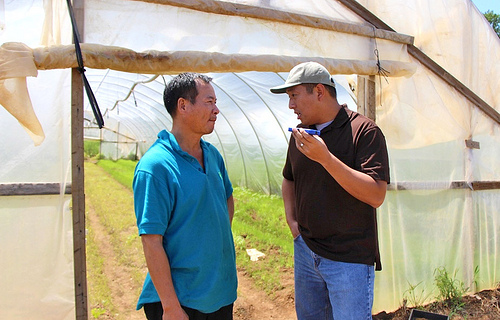Milk production surveys are back. Beginning in October, the USDA National Agricultural Statistics Service will resume the quarterly producer surveys that are used to forecast future milk supply. The surveys were suspended in April due to budget restraints caused by sequestration. Producers can expect to receive survey mailings in late September. The first quarterly report is expected Oct. 21. Learn more.
Milk Production Surveys Make a Comeback
Farm Income Could be Second Highest on Record
 Farm income is forecast to be $120.6 billion in 2013, according to a report released this week by the U.S. Department of Agriculture. That is up 6 percent from the 2012 estimate of $113.8 billion. When adjusted for inflation, the 2013 farm income is expected to be the second highest on record since 1973. Record crop production leads the increase along with livestock, dairy and poultry production, which is expected to increase more than 5 percent in 2013. Read the report.
Farm income is forecast to be $120.6 billion in 2013, according to a report released this week by the U.S. Department of Agriculture. That is up 6 percent from the 2012 estimate of $113.8 billion. When adjusted for inflation, the 2013 farm income is expected to be the second highest on record since 1973. Record crop production leads the increase along with livestock, dairy and poultry production, which is expected to increase more than 5 percent in 2013. Read the report.
RMA Clarifies Acreage Eligibility for Preventive Planting in Prairie Pothole Region
The U.S. Department of Agriculture’s Risk Management Agency announced special provisions this week to clarify acreage eligible for prevented planting in the Prairie Pothole region. “The goal is to make federal crop insurance policy more objective and to provide clarity for the producers facing prevented planting losses,” said RMA Administrator Brandon Willis. The updates eliminate the “normal weather” provision, providing a more objective means for determining eligibility, and remove a provision disqualifying land for prevented planting if marsh vegetation is found. Learn more.
Farmers Doing More With Less Water
Some farmers are investing in irrigation systems to help find the “sweet spot” between too much water and not enough water for their crops. “What we’re trying to figure out is how to continue to get good yields with less water,” said USDA Researcher Tom Trout. That’s the top question for farmers who rely on irrigation. By giving crops the right amount of water at the right time will save water. By using a drip irrigation system that cost about $4,000 per acre, one Colorado farmer now uses 30 percent less water than he did with a sprinkler system. Read more (KCUR).
Study: Stroke Risk Could Possibly be Linked to Soil Characteristics
USDA researchers may have found a link between soil characteristics and stroke risk. A study in several South Carolina counties with the 10 highest stroke rates showed that people living in an area with a soil depth to water table from 20-59 inches had a higher stroke mortality rate. The same held true for moderately well-drained to poorly drained soils and strongly acidic soils found in the region’s Coastal Plains. By contrast, the stroke rate was lower in areas of well-drained soils and soils with a depth to water table below 79 inches. Scientists believe microbes in the soil, or a lack thereof, could be contributing to these incidents and affecting human health. Learn more.
FSA Bolsters Couple to Receive TN Farmer of the Year Award

The Koop family. Pictured (from left top) Creyo and Milly Koop; (bottom) Chad, Maddy, and Marty Koop.
(Reprinted from Marshal County Tribune)
A Cornersville farm family received the prestigious Tennessee Small Farmer of the Year Award last week in Nashville, rewarding their hard work and dedication on the family farm.
On July 18 at Tennessee State University, Marty and Chad Koop also received the Innovative Marketing Award. To win they competed against other small farmers in the state who were nominated by local, state, and federal agricultural agencies as outstanding producers in their area. The awards were presented at the Tennessee Small Farm Expo. Continue reading
Super Storm Sandy Whips Up Super Recovery Satisfaction

New Jersey farmer Liang Shao Hua listens to NRCS technical advisor Frank Wu provide advice in Chinese Mandarin, Liang’s native language. His limited English proficiency restricted his exposure to USDA farm programs until Tropical Storm Sandy made it necessary for Liang to connect with the department for assistance. He is now an FSA loan recipient and appreciates the cost-share benefits of the Emergency Conservation Program funds that assisted his family’s clean-up efforts.
By Kent Politsch, Chief, FSA Public Affairs
Disasters create pain. And recovery from disasters creates partnerships and opportunity.
That is the lesson Liang Shao Hua learned in the past year after Tropical Storm Sandy, also known as Super Storm Sandy, destroyed his New Jersey high-tunnel farming operation and left him wondering how to manage his loss.
Liang, a Chinese American with very limited English proficiency, relied first on his American-born son, Peter, a 21-year-old college student studying at John Jay College of Criminal Justice, New York. Peter obtained USDA paperwork from the Farm Service Agency (FSA) that helped his father apply for Emergency Conservation Program (ECP) funds. He, his brother, David, 19, and mother, Pei Yin, joined Liang in the clean-up efforts. Continue reading
Unmanned Helicopter Could Help Protect Crops
Millennial Generation Breaking the Bank Before Hitting the Farm
The organic generation wants to farm but not the traditional way. They are more interested in small-scale operations, but access to land and capital are shocking many of them into reality. Many have opted to work in large agribusinesses but others who want to work the field are taking on loans and working multiple jobs just to get started. Listen to more (NPR).
Nebraska’s FFA Youth Leaders Impressed and Impressive

Spencer Hartman, Nebraska FFA Association president, and Bryce Doeschot, the association’s secretary, joined FSA Administrator Juan M. Garcia and Deputy Administrator for Farm Loan Program Chris Beyerhelm in a lighter moment during a visit in Garcia’s office.
By Kent Politsch, Chief, FSA Public Affairs
It’s a big deal when you’ve just graduated from a small town high school in Western Nebraska to make a trip to Washington, D.C. It’s especially a big deal when you get to sit in the office of the Administrator of the Farm Service Agency while in D.C. and share your thoughts.
Spencer Hartman made the trip recently. He sat with FSA Administrator Juan M. Garcia and Deputy Administrator for Farm Loan Programs Chris Beyerhelm. He was joined by colleague Bryce Doeschot, also a Nebraska native but from the opposite side of the state. They talked about farming. Continue reading





